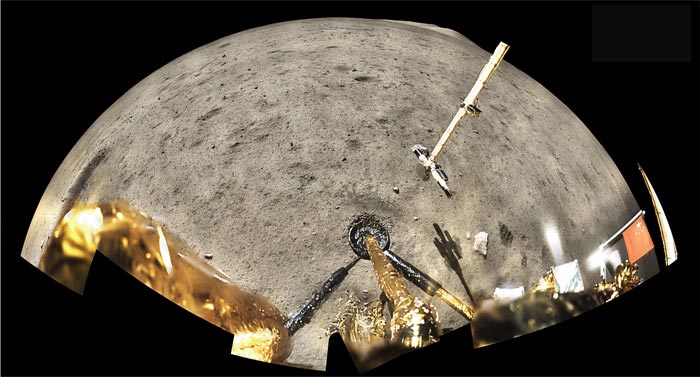Curtin researchers help date the youngest rocks ever found on the Moon

China’s Chang’e-5 Moon landing in December 2020
Credit: Chinese National Space Agency Lunar Exploration and Space Engineering Center
Curtin University researchers have helped to determine the age of the youngest rocks ever found on the Moon, as part of a global space mission that is working to refine the chronology of the entire Solar System.
The new research, published in Science, determined the basaltic volcanic rocks, collected as part of China’s Chang’e-5 Moon landing in December 2020, were about two billion years old – or one billion years younger than those previously found on the Moon.
The rock samples were collected by the Chinese National Space Agency during the Chang’e-5 mission, which marked the first time any nation had collected rocks from the Moon since 1976.
Lead Australian author Professor Alexander Nemchin, from Curtin University’s Space Science and Technology Centre in the School of Earth and Planetary Sciences, said researchers determined the age of the lunar rock samples during remote sessions with the Beijing laboratory using large mass spectrometers that have helped revolutionise geology, similar to Curtin’s Sensitive High Resolution Ion Micro Probe Facility (SHRIMP).
“Previously, the youngest lunar basalt rocks collected as part of the Apollo and Luna missions, as well as lunar meteorites, were found to be older than about three billion years,” Professor Nemchin said.
“After analysing the chemistry of the new Moon rocks collected as part of China’s recent mission, we determined the new samples were about two billion years old, making them the youngest volcanic rocks identified on the Moon so far.
“This discovery puts Australia at the heart of efforts to internationalise scientific collaboration around China’s lunar exploration program, including samples returned from China’s Chang’e-5 mission and the upcoming Chang’e-6 Moon landing in 2024.”
Co-author Professor Gretchen Benedix, also from Curtin’s Space Science and Technology Centre, said the new results would provide researchers with more calibration points for cratering chronology, enabling them to derive more accurate and higher resolution ages across many planetary surfaces.
“These results confirm what experts had long predicted based on remotely obtained images of the Moon and raise further questions as to why these young basalts exist,” Professor Benedix said.
“The task will now turn to finding a mechanism that will explain how this relatively recent heating of the Moon may have supported the formation of basaltic magmas with temperatures exceeding 1000 degrees Celsius – and ultimately help researchers improve age dating of the entire Solar System.”
The research was carried out in collaboration with experts from the International Lunar and Planetary Research Center of China, The Beijing SHRIMP Center, The Australian National University, Washington University in St Louis, Notre Dame University and Brown University in the United States of America, the University of Colorado, Manchester University in the United Kingdom and the Natural History Museum in Sweden.
Journal: Science
Article Publication Date: 8-Oct-2021
Media Contact
Yasmine Phillips
Curtin University
yasmine.phillips@curtin.edu.au
Office: Australia
Cell: 0401103877
All latest news from the category: Physics and Astronomy
This area deals with the fundamental laws and building blocks of nature and how they interact, the properties and the behavior of matter, and research into space and time and their structures.
innovations-report provides in-depth reports and articles on subjects such as astrophysics, laser technologies, nuclear, quantum, particle and solid-state physics, nanotechnologies, planetary research and findings (Mars, Venus) and developments related to the Hubble Telescope.
Newest articles

NASA: Mystery of life’s handedness deepens
The mystery of why life uses molecules with specific orientations has deepened with a NASA-funded discovery that RNA — a key molecule thought to have potentially held the instructions for…

What are the effects of historic lithium mining on water quality?
Study reveals low levels of common contaminants but high levels of other elements in waters associated with an abandoned lithium mine. Lithium ore and mining waste from a historic lithium…

Quantum-inspired design boosts efficiency of heat-to-electricity conversion
Rice engineers take unconventional route to improving thermophotovoltaic systems. Researchers at Rice University have found a new way to improve a key element of thermophotovoltaic (TPV) systems, which convert heat…



